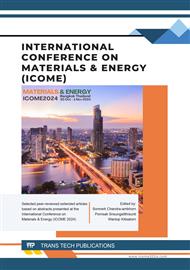[1]
American Welding Society. (2011). Welding handbook: Volume 4, Materials and applications, Part 1 (9th ed., pp.394-396).
Google Scholar
[2]
Lipold, J. C., & Kotecki, D. J. (n.d.). Welding metallurgy and weldability of stainless steel. Wiley Interscience publication.
Google Scholar
[3]
Application Wave form Control Technology (STT). (n.d.). Surface Tension Transfer Wave Form Control STT. Lincoln Electric.
Google Scholar
[4]
STT. (2015). Pipe Root Pass Weld Process Guide. Lincoln Electric.
Google Scholar
[5]
Adi, P., Isamar, H., & Tazi, P. (2015). Advantages of MAG-STT welding process for root pass welding in the oil and gas industry. TEM Journal, 76-79.
DOI: 10.18421/tem51-12
Google Scholar
[6]
Phengprakhon, P., Lertvijitpun, P., & Thonondaeng, T. (2023). Study on mechanical properties and metallurgy structure of dissimilar pipe joining between ASTM A312 Gr. TP316/316L and ASTM A106 Gr.B with gas metal arc welding – surface tension transfer and gas tungsten arc welding processes. In The Conference of Industrial Engineering Network (IE NETWORK 2023) (pp.741-746). Chonburi, Thailand.
DOI: 10.5781/jwj.2016.34.3.69
Google Scholar
[7]
American Society of Mechanical Engineers (ASME). (2023). ASME Boiler and Pressure Vessel Code: Section IX.
Google Scholar
[8]
American Society of Mechanical Engineers (ASME). (2022). ASME Code for Pressure Piping, B31.3.
Google Scholar
[9]
Ghasemi, R., Beidokhti, B., & Fazel-Najafabadi, M. (2018). Effect of Delta Ferrite on the Mechanical Properties of Dissimilar Ferritic-Austenitic Stainless Steel. Archives of Metallurgy and Materials, 63(1), 437-443.
DOI: 10.24425/118958
Google Scholar
[10]
Kazemi, A., Shariat, M. H., & Hashemi, B. (2021). Investigation on Corrosion Behaviors of Different Zones of Dissimilarly Welded A312TP316L and A106Gr.B in the Brine Solution Containing H2S and CO2. Journal of Bio- and Tribo-Corrosion, 7(1), 132.
DOI: 10.1007/s40735-021-00569-6
Google Scholar
[11]
Chuaiphan, W., & Srijaroenpramong, L. (n.d.). Optimization of TIG welding parameter in dissimilar joints of low nickel stainless steel AISI 205 and AISI 216. Journal of Manufacturing Process.
DOI: 10.1016/j.jmapro.2020.07.052
Google Scholar
[12]
Lacombe, P., Baroux, B., & Beranger, G. (1993). Stainless steel. Les Editions de Physique Les Ulis.
Google Scholar
[13]
Lin, Y. C., & Chen, P. Y. (2011). Effect of nitrogen content and retained ferrite on the residual stress in austenitic stainless steel weldments. Journal of Materials Science & Engineering A, 307, 165-171.
DOI: 10.1016/s0921-5093(00)01821-9
Google Scholar
[14]
Jang, A. Y., Lee, D. J., Lee, S. H., Shim, J. H., Kang, S. W., & Lee, H. W. (2011). Effect of Cr/Ni equivalent ratio on ductility-dip cracking in AISI 316L weld metals. Journal of Materials Design, 32, 371-376.
DOI: 10.1016/j.matdes.2010.06.016
Google Scholar



